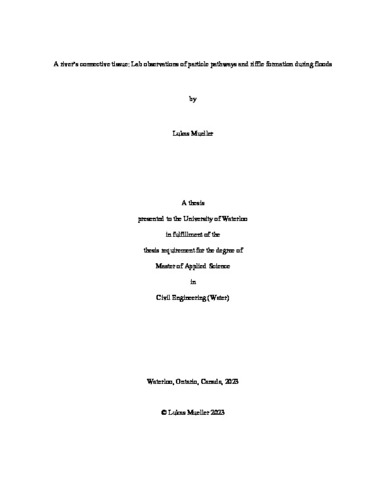| dc.contributor.author | Mueller, Lukas | |
| dc.date.accessioned | 2024-01-05 16:44:25 (GMT) | |
| dc.date.available | 2024-01-05 16:44:25 (GMT) | |
| dc.date.issued | 2024-01-05 | |
| dc.date.submitted | 2023-11-27 | |
| dc.identifier.uri | http://hdl.handle.net/10012/20214 | |
| dc.description.abstract | In rivers it is difficult to quantify bedform dynamics during storm events. Direct observation of
sediment pathways would provide insight into the mechanisms that underly bedform formation and
destruction. In the current study, our objective was to visualize these processes in a meandering pool riffle system with partial bed cover. Observing erosive and depositional patterns, as well as the locations
of active sediment transport, provides insight into the validity of various pool-riffle maintenance
theories. We used a physical 1:40 scaled model of Toronto’s Wilket Creek to simulate storm events
during which riffles formed as connective bedforms between alternate point bars. Exported sediment
was weighed and sieved to measure the grain size distribution, while the bed’s pre- and post- storm
topography was quantified using Structure-from-Motion techniques. Sediment pathways were observed
using a novel technique, where regions of interest were filmed at 60 frames per second under ultra violet light, illuminating painted tracers. Three paint colors were used for different size tracers, which
allowed us to apply image segmentation and create separate videos for three size fractions of the
sediment. Pathways were then extracted using Lagrangian tracking software. Results show that the area
of active transport is limited to a narrow portion of the channel width that increases with flood stage.
At low flow, transport is routed along the toe of point bars, while no particles travel into the region of
the pool, where the bed is uncovered. Riffles are rarely observed at these stages. As the flow increases,
the lateral extent of active transport expands to include the higher parts of the bars, while connective
riffles grow in areal extent and height. Erosion and deposition was found to occur more readily along
the active sediment transport zones. Pathways varied by particle size so that smaller particles traveled
higher over the point bar and large particles tended to collect in the riffle. These results indicate that
sediment-routing is a dominant mechanism behind the formation and maintenance of riffles in
meandering rivers. Future work to quantify these processes will increase the effectiveness and longevity
of river remediation design through targeted sediment augmentation instead of bedform reconstruction. | en |
| dc.language.iso | en | en |
| dc.publisher | University of Waterloo | en |
| dc.subject | river | en |
| dc.subject | sediment transport | en |
| dc.subject | pool | en |
| dc.subject | riffle | en |
| dc.title | A river's connective tissue: Lab observations of particle pathways and riffle formation during floods | en |
| dc.type | Master Thesis | en |
| dc.pending | false | |
| uws-etd.degree.department | Civil and Environmental Engineering | en |
| uws-etd.degree.discipline | Civil Engineering (Water) | en |
| uws-etd.degree.grantor | University of Waterloo | en |
| uws-etd.degree | Master of Applied Science | en |
| uws-etd.embargo.terms | 0 | en |
| uws.contributor.advisor | MacVicar, Bruce | |
| uws.contributor.affiliation1 | Faculty of Engineering | en |
| uws.published.city | Waterloo | en |
| uws.published.country | Canada | en |
| uws.published.province | Ontario | en |
| uws.typeOfResource | Text | en |
| uws.peerReviewStatus | Unreviewed | en |
| uws.scholarLevel | Graduate | en |

